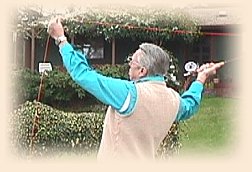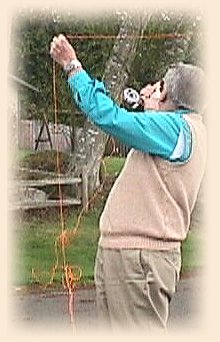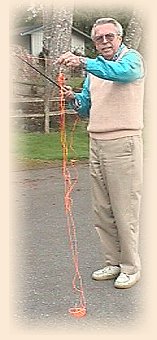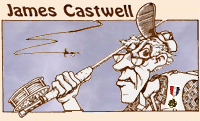|
So . . . there I was. The rod arrived the day before yesterday but I hadn't
had time to play with it. A five weight, eight and a half foot beauty and I
was anxious to test it out. I discovered I had an old reel with a very old
weight-forward line and decided to have a go at it . . . Goodie-goodie! Time
to take the outfit outside and play, it wasn't raining all that hard. And so
what if the wind was whistling about twenty. I had the time and I was
going to see what this thing would do.
In my case, outside means the street in front our house. It is a rather quiet
neighborhood and those who live around here are used to seeing me
pirouetting about with a fly rod at any given time of day; they simply
ignore me. Stringing it up I noticed the leader was not too hot; a rather
knotted four foot piece of what had in it's day probably been a nice nine-footer.
Not so now, but what the heck, I was ready, let the games begin!
I often cast in the street and relegate the lines I use to practice only. The
pavement raises hob with them and seems to impart a grade of dirt which
defies removal. Once used there, they stay practice lines, period. I turned,
facing into the wind and after pulling out line until I reached the narrow
running line (this starts at the back of the weight-forward head part)
commenced to wave some line into the air.
The reel was a small one I had used for little stream work and had no backing,
there simply was not any room for any, the line filled the reel to the very top.
The first few casts were made by holding the line firmly against the cork with
my casting hand, nothing in my left hand. I do this when learning a new rod.
Not long casts either, maybe twenty to thirty feet at first. Big loops and small,
over-head, side arm, slow and fast, just the tip of the rod, and them more of it.
All this time I am watching the rod itself and the shape of the loops of line.
Somehow all of this seems to combine into one composite thought; it is ok,
do I like it, does the rod cast as I think it should, things like that.

After a determination of the ability of the rod at these distances I take the
line with my left hand and feed some into the hungry creature. Foot by foot
I add line and cast only with my casting (in my case, right) hand. The front
loops were forming perfectly into the wind, controlled loops and tight wedges.
I kept the casts low and tight; the facing wind made my back-casts picture
perfect. They were responsible for the shape of my front loops. All evolved
as I had hoped. It was a strong and powerful rod with the ability to punch
into a breeze and still lay down a finessed presentation.
 "OK," I thought, now let's see what this thing will do. I decided I would add
some double-haul and 'stretch some fly line,' as the saying goes. I peeled off
most of the ninety-foot line and commenced to add a bit of pressure to the casts.
Fifty, sixty, sixty-five, seventy, seventy-five and then it happened. Jam-up!
"OK," I thought, now let's see what this thing will do. I decided I would add
some double-haul and 'stretch some fly line,' as the saying goes. I peeled off
most of the ninety-foot line and commenced to add a bit of pressure to the casts.
Fifty, sixty, sixty-five, seventy, seventy-five and then it happened. Jam-up!
 What's a 'Jam-up,' you ask? It is caused by the stupid notion that one can cast
the whole fly line when it has been wound tightly on a darn little reel for a few
years and is better suited as a watch-spring. It's the mess of fairly tightly twisted
coils of fly line that materializes during the forward cast and smacks against the
first (stripping) guide on the butt section of the rod. This keeps anything from
advancing whatsoever. The cast stops with a jerk (no pun here please) and
causes much embarrassment if onlookers should unfortunately be present
(fortunately, I had none). As the air temperature was about fifty degrees
the memory-transfixed line refused with any amount of tugging and pulling
to remain in any attitude other than 'coiled'!
What's a 'Jam-up,' you ask? It is caused by the stupid notion that one can cast
the whole fly line when it has been wound tightly on a darn little reel for a few
years and is better suited as a watch-spring. It's the mess of fairly tightly twisted
coils of fly line that materializes during the forward cast and smacks against the
first (stripping) guide on the butt section of the rod. This keeps anything from
advancing whatsoever. The cast stops with a jerk (no pun here please) and
causes much embarrassment if onlookers should unfortunately be present
(fortunately, I had none). As the air temperature was about fifty degrees
the memory-transfixed line refused with any amount of tugging and pulling
to remain in any attitude other than 'coiled'!
To this day I am firmly convinced the rod would have taken the whole line,
even into the wind, but it sadly was not to be, at least not on that day. And
it was at that point I learned something of value. No wonder many of you do
not know how to double-haul. True, most of you feel you have no use for it
and you are probably mostly right. But if you have a fly line anything like the
one I had you couldn't get enough fly line into the air to make it fun in the
first place.
Now, it is very true, I use the 'DH' on nearly all casts, it has become a habit
and makes casting easier as it divides the work part of casting between both
hands, not just doing it all with my right hand. So my good friends, there you
have it. I have been wrong to harangue about you learning the DH when you
really do not have what may be correct to attempt to learn it at all.
Perhaps in the future you can find a rod and a reel of proper size with some
backing so the line is not all jammed onto the tiny core of the little winch and
have a go at it. Maybe some coaching will be available as well, it couldn't hurt.
As for me, I need to re-spool the line onto a larger reel, submerge the whole
thing into some rather warm water for a while and then, away we go again. I
will bring the rod to the 'Fish-In 2001' and you can all play with it. But, be
careful, it will be my main rod along with a seven and a half foot three weight
I am bringing. (Which I also double-haul most of the time too).
P.S. The rods? Gatti, three piece, progressive.
~ James Castwell
|



